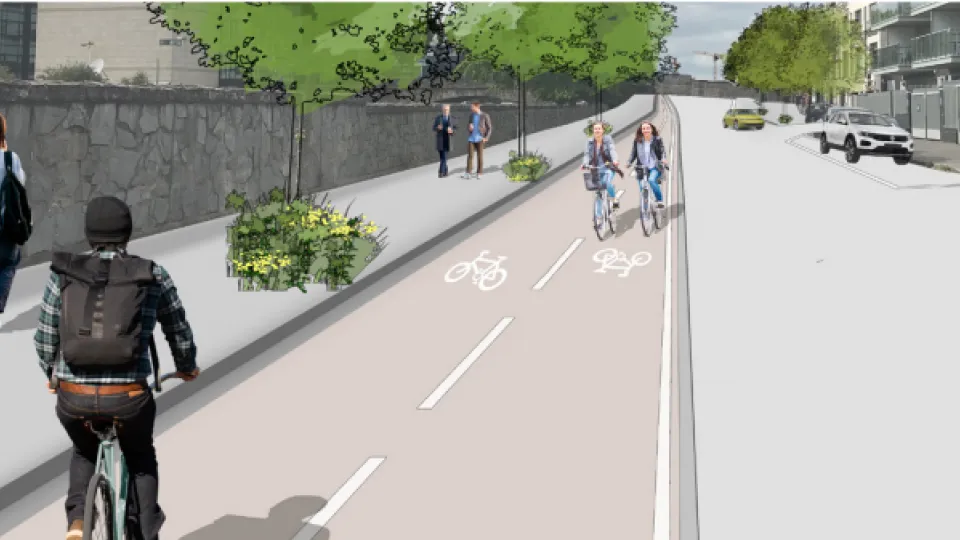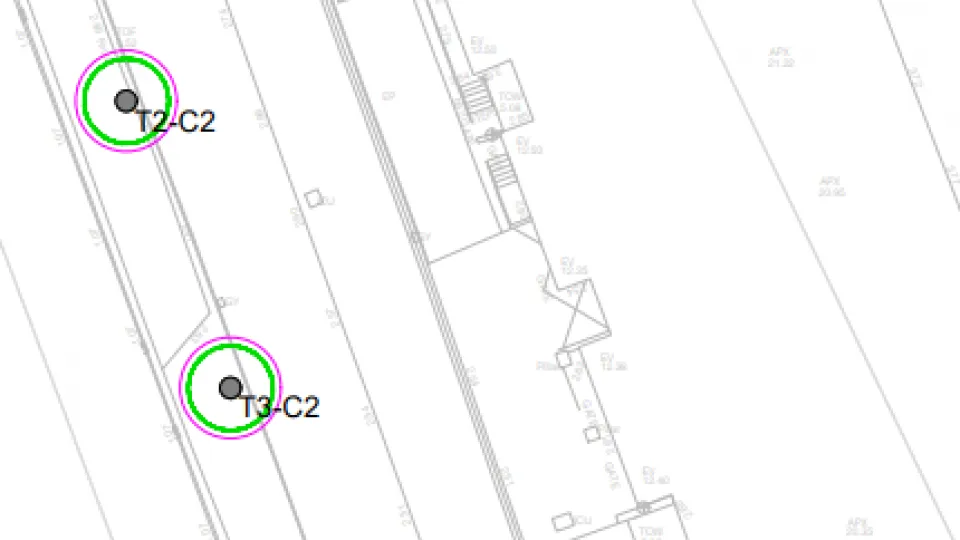The Dodder Greenway: Fitzwilliam Quay to Londonbridge Road
This section of the Dodder Greenway will provide 0.5km of walking and cycling facilities from Fitzwilliam Quay to Londonbridge Road. The Construction phase of this section is due to start in Q3 2025.
The Fitzwilliam Quay to Londonbridge Road scheme will provide walking and cycling infrastructure as part of the wider Dodder Greenway scheme. The scheme will make it safer and more pleasant to walk and cycle while improving the look and feel of the area.
The scheme’s key components are:
- Signalised junction at the Bridge Street / Fitzwilliam Quay junction, with new pedestrian and cyclist crossings across Bridge Street and Fitzwilliam Quay
- Three-metre wide, two-way cycle lane on the western side of Fitzwilliam Quay, separating cyclists from traffic by way of segregation kerbs
- Three-metre wide, two-way cycle lane along the existing green space outside the western wall of Dodder Park
- Quiet street, which mixes cyclists and vehicles, along the existing road section which links the Pumphouse Apartments to Londonbridge Road by way of road markings
- Removal of long-stay commuter parking on Fitzwilliam Quay
- Climate change mitigation measures including:
- piloting Red Permeable Paving on the cycle lanes
- installing flood alleviating one-way valves on drainage connections to The Dodder
- Improved connectivity from the city centre to upstream Dodder Greenway schemes
These changes will produce multiple benefits as listed below.
Scope and Purpose
Concept Development and Option Selection
Preliminary Design
Statutory Processes and Public Consultation
Detailed Design and Procurement
Construction
Close-Out and Review
Learn More About This Section
The scheme will produce multiple benefits including:
- By providing safer, segregated infrastructure, the scheme will open cycling up to more people, for example students cycling to schools in the area.
- By making it safer and more pleasant to walk and cross the road, the scheme will facilitate more people, including people with limited mobility, to walk in the area.
- By linking into Dublin City Council’s 314km Active Travel network, including the adjacent Beatty's Avenue to Herbert Park Scheme (under construction) and Ringsend to City Centre Scheme, the scheme will connect communities by enabling people to walk and cycle safely and with ease across the city.
- Facilitating more people to walk and cycle, rather than use the private car, will help reduce transport emissions and improve air quality for residents.
- The new infrastructure and removal of long-stay commuter parking on Fitzwilliam Quay will enhance the attractiveness of the public realm, improving the day-to-day experience of residents and visitors.
- With its climate mitigation measures, the scheme will lower flood risk and support carbon reduction.
- Active travel produces a range of personal, social and economic benefits such as improving people’s physical and mental health, fostering social interaction, and stimulating local business activity.
Dublin City Council will deliver the 314km Active Travel Network through a series of infrastructure projects over the coming years.
Fitzwilliam Quay to Londonbridge Road will provide walking and cycling facilities from Fitzwilliam Quay to Londonbridge Road as part of the wider Dodder Greenway scheme.
When complete, the Dodder Greenway will deliver high quality walking and cycling facilities along the Dodder River from the sea to the mountains through Dublin City Council, Dún Laoghaire Rathdown County Council and South Dublin County Council.
This scheme will provide an Active Travel link along the Dodder River, as part of the Dodder Greenway scheme, and into future cycle and public transport schemes. The overall aim is to improve walking and cycling facilities for the local communities, facilitating the shift towards more sustainable modes of transport for both commuting and leisure.
The current nature of the area covered by the Fitzwilliam Quay to Londonbridge Road scheme, including its use for long-stay commuter parking and lack of segregated infrastructure, make it unattractive for some people to walk and cycle. This scheme intends to address this, opening active travel up to more people.
A non-statutory public consultation process was carried out. The Public Consultation Report can be found on the scheme's Publications and Reports webpage.
An information event on the project was held from 4-7pm on 15 June 2023 in Sandymount Community Centre, Newbridge Avenue, Sandymount, Dublin. This was an opportunity for the public to discuss the proposals with Dublin City Council and give their feedback on the proposals.
This scheme is funded by the National Transport Authority.
In order to deliver this scheme, there will be some minor temporary disruption to traffic in the area during construction. Dublin City Council, in collaboration with our contractor, will endeavour to minimise this as much as possible.
Yes. Traffic impacts along the route have been considered as part of the environmental screening exercise.
To read the full report, visit our 'Publications and Reports' webpage.
Yes. Two screening assessments have been completed for this scheme:
Both screening reports concluded that an Environmental Impact Assessment report and Appropriate Assessment Report are not required for the scheme.
No. All works proposed remain outside of the river and its banks. Existing footpaths and road space is used for the new infrastructure instead.
Parking will be maintained on the east side of Fitzwilliam Quay. Existing free parking arrangements on the west side of Fitzwilliam quay will be removed.
Parking Surveys were conducted on Fitzwilliam Quay in March 2023, which indicated that spaces are being used for long term parking; average parking duration on this stretch was observed to be 8.9 hours per vehicle.
An objective of the Dublin City Development Plan 2022-2028 is:
"Elimination of ‘Free’ On-Street Parking to progressively eliminate all ‘free’ on-street parking, both within the canals and in adjacent areas where there is evidence of ‘all day’ commuter parking, through the imposition of appropriate parking controls, including resident permit parking, pay and display parking, or by the provision of new cycle parking, public realm or greening."
The existing taxi rank will be relocated from the west side of Fitzwilliam Quay to the east side of Fitzwilliam Quay.





